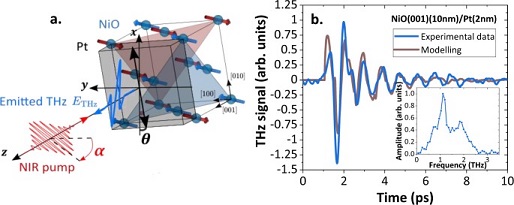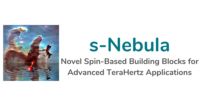News from the partner CNRS/Thales. Collaboration involving 4 partners from s-Nebula consortium: CNRS (CNRS-UMPhy, LPENS), Johannes Gutenberg University, Frei Universität of Berlin and Thales.
Free-space THz emission resulting from the femtosecond demagnetization of a spintronic THz emitter, and the subsequent spin-charge conversion in high spin-orbit material, has recently been routinely used to produce THz pulses which polarization can be tuned by magnetic fields and covers continuously the THz gap from 0.3 to 30 THz. The next generation of spintronic THz emitters would benefit from additional functionalities, such as unlocking a narrowband and tunable THz generation regime to target medical and telecommunications applications.
In a recent work published in Nature Communications, we report in collaboration with Laboratoire de Physique de l’ENS, Freie Universität Berlin, Mainz-University, Potsdam University and the University of Tokyo on the combined narrowband and broadband THz emission using an antiferromagnet/heavy metal structure, which are known to possess their modal modes in the THz range. More particularly, we identified two THz generation mechanisms which arise from different excitation rules of THz spin-currents for two growth orientations of the bilayer: NiO(111)/Pt and NiO(001)/Pt. In the latter bilayer NiO(001)/Pt, we unravelled a new working mechanism based on spin-phonon interactions. In this scheme, 1 THz magnons are generated by heating of the Pt layer which acts as a heat-to-strain transducer. Thus, the launched strain wave induces in NiO an excitation of the high frequency mode due to strong magneto-strictions. This work opens routes towards future antiferromagnet based THz spintronic devices.
This work has been funded from the Horizon 2020 Framework Program of the European Commission under FET-Open grant agreement No. 863155 (s-Nebula).
Emission of coherent THz magnons in an antiferromagnetic insulator triggered by ultrafast spin–phonon interactions
E. Rongione et al., Nat Commun. 14, 1818 (2023).
https://doi.org/10.1038/s41467-023-37509-6

